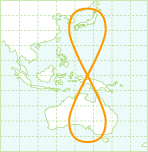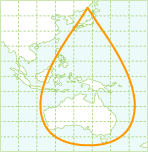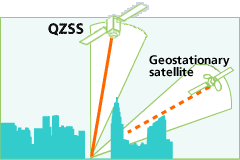Unique orbit to Japan
 The orbit of the quasi-zenith satellite is unique to applications in Japan. The geostationary orbit is generally above the equator. If we tilt the geostationary orbit to move it above us, we can create an orbit that passes just above Japan. However, that is not enough to have a satellite always on top of Japan because the orbit is slanted, thus a satellite is gradually changing its angle and moving toward the south or the north due to the Earth’s rotation. Consequently, a satellite can stay over Japan only for seven to nine hours. By flying a multiple number of satellites that take turns, we can always have one satellite above Japan all the time.
The orbit of the quasi-zenith satellite is unique to applications in Japan. The geostationary orbit is generally above the equator. If we tilt the geostationary orbit to move it above us, we can create an orbit that passes just above Japan. However, that is not enough to have a satellite always on top of Japan because the orbit is slanted, thus a satellite is gradually changing its angle and moving toward the south or the north due to the Earth’s rotation. Consequently, a satellite can stay over Japan only for seven to nine hours. By flying a multiple number of satellites that take turns, we can always have one satellite above Japan all the time.Quasi-zenith satellite orbit
The footprint of a quasi-zenith satellite orbit looks like the figure "eight (8)" (or the satellite looks like depicting "eight (8)" as it flies) if you look at its flight path while having the Earth stationary. Therefore, it was originally nicknamed a "Figure-8 satellite."Some other orbits apart from the figure-8 orbit were also considered.
If we tilt an orbit against the equator and make it an oval (with larger eccentricity) to have its apogee position over Japan, we can maximize the time duration of the satellite staying over Japan. In such a case, the orbit becomes "asymmetry figure-8" or the "shape of a tear."
Advantages of each orbit
 Symmetry figure-8:
Symmetry figure-8:
It is symmetrical in a north-south direction, thus the same service can be provided to the southern hemisphere including Australia.
 Asymmetry figure-8
Asymmetry figure-8
The orbit that is adopted for the Quasi-Zenith Satellite System has an advantage that it can easily switch connection from satellite to satellite when the system is used for satellite broadcasting services. Its merit is that a satellite can stay a longer time over Japan compared to the symmetry figure-8 orbit.
 Tear shaped
Tear shaped
This orbit enables a satellite to stay much longer over Japan, but the distance between the satellite and the Earth is drastically changing, thus some technical challenges arise for service provision in Asia and Oceania. Consequently, this orbit was not selected for the Quasi-Zenith Satellite System.
What is Quasi-Zenith Orbit
without any obstacles
 Watching from the sky The biggest characteristic of a quasi-zenith satellite is, as the name explains, that users can receive signals from a satellite that is flying just above them, on a quasi-zenith orbit, with few obstacles.
Watching from the sky The biggest characteristic of a quasi-zenith satellite is, as the name explains, that users can receive signals from a satellite that is flying just above them, on a quasi-zenith orbit, with few obstacles. Japan is located in the mid level of the northern hemisphere. Accordingly, when we receive signals from a geostationary satellite (*1) an antenna has to be tilted by about 30 to 50 degrees toward the equator in order to receive signals (the angle depends on regions and the longitude of a geostationary satellite.) Because of this slant, signals were often hampered by mountains or buildings.
The geostationary satellite orbit is above the equator. A satellite on this orbit travels around the Earth at the same period with that of the Earth, thus it looks like it is stationary above us when we look at it from the Earth. That is why it is called “geostationary.” As it always transmits signals from the same direction, we can receive signals by fixing antennas in one direction, such as the use of antennas for broadcast satellites (BS) or communications satellites (CS.)
On the other hand, with the quasi-zenith satellite system, we can receive signals from a satellite directly above of us. Hence, its application is highly expected to improve efficiency of the GPS especially in mountainous regions and urban areas with skyscrapers.
Satellite positioning requires at least four satellites. In addition, in order to improve positioning accuracy, the geometric deployment of satellites is also very important. A quasi-zenith satellite contributes to improve the geometric deployment.
More detailed explanation:
For high accuracy positioning, it is crucial that which satellites are available in what direction from a location to be positioned. If all available satellites concentrate on one side, ranging errors get bigger, thus positioning accuracy deteriorates.Idealistically, the best geometric deployment of satellites is one satellite at the zenith and three broadly scattered on the horizon. With the quasi-zenith satellite system, at lease one satellite will be located at the zenith, thus it will help creating the idealistic geometry deployment. As a result, the Geometric Dilution of Precision (GDOP) gets smaller to improve positioning accuracy.
